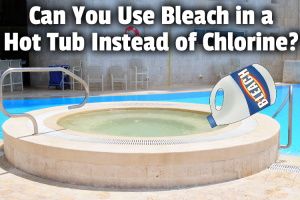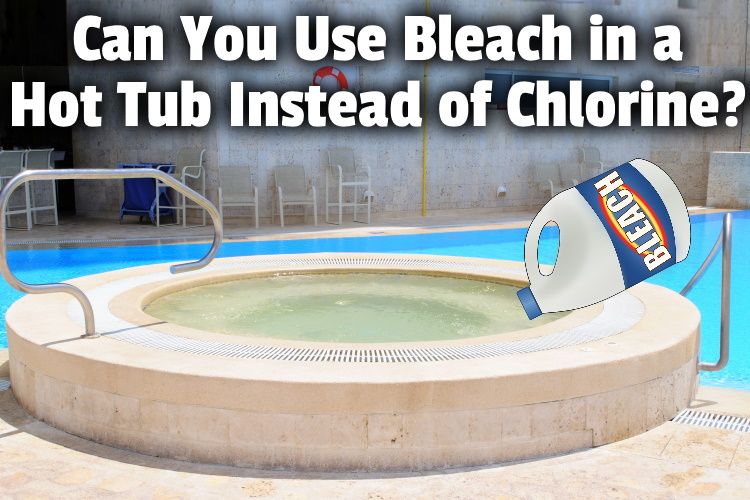I know using chlorine in your hot tub can be expensive, and bromine even more so, which made me wonder, can you use bleach in a hot tub instead of chlorine?
You can use 1/8 cup liquid bleach for a weekly hot tub shock. However, it is unwise to use it as a regular sanitizer due to the concentration. Diluted bleach can also be used to clean the shell of a hot tub when it’s empty. Just be sure to rinse off before refilling.
But that’s not all there is to know!
So in this article, we’ll explore why you might want to use liquid bleach instead of chlorine powder or tablets. We’ll also look at whether that’s OK to use any of that with bromine sanitizer too. And we’ll take a look at the most economical way to keep your hot tub clean and sanitized.
Let’s get started!
Is household bleach different from what you use in a hot tub?
Household bleach is a solution of around 5 or 6% sodium hypochlorite and water. This is very similar to pool and spa shock which is often Dichloro-S-Triazinetrione that has also been diluted with water. However, many hot tub shocks also contain clarifiers or algaecides.
But again, you shouldn’t use it as an alternative to chlorine or bromine sanitizer. It’s too strong for that.
As I’ve mentioned, if you want to use it, use it as your weekly shock. Just a cap-full will do for an average-sized hot tub but read this recent article first before trying it as part of safety precautions.
Then leave the lid off for at least 20 minutes with the jets on. Then leave it a few hours before getting in after adding bleach because this is a high concentration of chlorine.
It can contain as much as 10 parts per million (ppm) compared to the recommended 1 to 3 ppm. You must check the pH and Total Alkalinity after adding bleach, as this can change the levels.
If the pH is greater than 7.8 ppm, then it is too high, and this can cause scale to form on filters, pipes, and jets. TA should be below 120 ppm; otherwise, the sanitizer won’t work effectively.
And, of course, always check the chemical levels before you get in to soak.
Hot tub emptied, bleach scrubbed & almost ready for refill.. Got the pool boy on it who’s being ‘supervised’ by boss pic.twitter.com/YsXi9HgGLK
— Dave Darbel (@LuchaDarbel) April 22, 2015
Will bleach hurt my hot tub?
Ordinary household bleach is already diluted to the extent that it shouldn’t significantly harm the surfaces of your hot tub when cleaning, but it can cause discoloration of the lid and headrest pillows. Don’t add more than 1/8 cup to the water of a hot tub more than once per week as a shock.
You must take precautions when using bleach so wear gloves and make sure you don’t get it in your eyes.
Bleach is a high concentration of chlorine and chlorine is essential for keeping the water and surfaces clean – even bromine contains chlorine.
Bleach is also a great product for cleaning surfaces.
But for cleaning surfaces, it is best to dilute it 1:1 with clean water. Do not add other chemicals such as vinegar or ammonia as this can result in a reaction giving off hazardous fumes.
When you empty your hot tub, you can use this diluted mixture to simply mop the surfaces down. Be sure to rinse off the residue before refilling and dry off the surfaces with a cloth or sponge.
Or what I like to do after cleaning before refilling is to hose the shell down and then use a wet/dry vac like this one on Amazon to suck all that excess water and bleach out.
Then just fill it back up sparkling clean!
Duck Covers Essential Water-Resistant 86 Inch Square Hot Tub Cover Cap, Patio Furniture Covers 9I6HCCAhttps://t.co/3vmbmoNLnH pic.twitter.com/9uFgjFTKiU
— Deangelo73zen (@deangelo73zen) November 17, 2022
How do you sanitize a hot tub?
If you use chlorine to sanitize a hot tub, maintain a level of 1 to 3 ppm. As a guide, for a 260-gallon hot tub, that is 1½ teaspoons of granular chlorine every 2 or 3 days. For bromine sanitizer, add approximately 2 teaspoons every 4-5 days for a 260-gallon hot tub to maintain a level of 2 to 6 ppm.
Do not use liquid bleach to sanitize your hot tub!
You must be on top of the maintenance of your hot tub if you want a healthy, trouble-free spa experience every time you use it.
That means adding sanitizer every day or after each use and shocking it once a week. For most people, this comes down to a choice between chlorine and bromine.
Chlorine oxidizes contaminants and kills off bacteria within them, leaving behind chloramines.
This is what causes skin irritation and the bad smell often associated with chlorine. The filtration system will normally capture this, so it is important to clean your filter at least once a week.
Too much chlorine can harm you.
I wrote about this in a recent article. But there are some real dangers chlorine can pose, and 1 affects almost all of us without our even being aware! Just click that link to read it on my site.
Bromine tears apart contaminants through ionization, leaving bromamines.
These aren’t as bad as chloramines but still need to be filtered out. Both bromamines and chloramines reduce the effectiveness of the sanitizer, which is why you also have to shock the water regularly as well.
Chlorine acts more quickly than bromine, but bromine is more stable, so it works better in the warmer water of a hot tub.
Then to reactivate the sanitizer and get rid of those chloramines or bromamines, just shock your hot tub about once a week. While you can, as we’ve discussed, use liquid bleach to shock your tub, I really like this hot tub shock on Amazon.
Just click that link to see the current price on Amazon.
Hot tub safety knowledge:
Chlorine and bromine are the most commonly used disinfectants to maintain the proper level of disinfectant to ensure clean and safe water.
The temperature of a hot tub should be less than 40°C (104°F) Staying in it for less than 10 minutes at one time. pic.twitter.com/lp5qBeYaYm— Jazzispas (@jazzispas) December 5, 2018
What is the best chlorine for hot tubs?
The best chlorine sanitizer for hot tubs is Leisure Time Chlorinated Granules. Granules are better than tablets as they dissolve quicker and don’t require a floater which can bump into people soaking if not removed.
Chlorine comes in liquid, granules, or tablet form. Liquid chlorine is designed for swimming pools, and it is important that you only use products designed for spas and hot tubs.
And I like to use Leisure Time chlorinating granules on Amazon because they are specifically formulated for hot tubs. They are very effective at sanitizing and shocking the water, keeping it clean and crystal clear without upsetting the balance. You can buy it on Amazon. Just click on the link to check out the latest price.
I use ½ ounce of Leisure Time Spa 56 per 500 gallons of water to maintain a residual chlorine reading of between 2 to 3 parts ppm.
To use as a shock treatment, I double this.
A lot of people ask whether they should put chlorine in every day, so I wrote about this in a recent article, which you can read here on my website by clicking on the link.
If you prefer tablets, which is more “set-it-and-forget-it”, then just use a floating dispenser.
These are a great way of making sure you get a slow release of sanitizer, but note, if you use a dispenser for chlorine, don’t use the same dispenser for bromine. The chemical reaction can be dangerous.
So if you decide to switch from chlorine sanitizer to bromine, it’s best to wash out the floater thoroughly. And wait until you change your water.
Biguanide is an organic compound derived from guanidine, which is found in turnips and other vegetables. As a chlorine alternative for the hot tub, biguanides provide a more natural hot tub without the cost or hassle of sanitizer systems that require special equipment. pic.twitter.com/ZXxbYRsRrt
— The Cover Guy (@TheCOVERGuy) October 20, 2020
What can I use instead of chlorine in my hot tub?
The most common alternative to chlorine sanitizer for a hot tub is bromine. In many ways, bromine is better because it deteriorates less quickly in the higher temperatures of a hot tub and has to be added less frequently.
One of the best products out there is Leisure Time Bromine Granules from Amazon. These bromine granules dissolve completely without leaving a residue or cloudy water. You can get these on Amazon too.
Just click on the link to see the latest price.
However, if you are looking for something completely different, there are several alternatives. The first 4 below will require modifications to your hot tub unless you already have them built-in:
- Ultraviolet light: The water is passed through a tube and subjected to ultraviolet light, which kills bacteria. You will still need to shock your hot tub each week though.
- Ionization: This works by releasing silver and copper ions into the water to kill off bacteria and other contaminants. It isn’t 100% effective, so you still need some chlorine or bromine.
- Ozonation: An Ozonator injects ozone into the water, killing off germs and keeping the water clean and clear. You may still find you need some chlorine with these, and they have to be on all the time to work.
- Salt water generation: The salt water is converted to chlorine, which is a natural by-product of the process and is less harmful than the chlorine used in pools and spas.
- Biguanide: This chemical is commercially available as BaquaSpa from Amazon, and while it does keep the water clean, you will still need to shock it. To do this, you must use a non-chlorine or non-bromine-based shock, never a chlorine-based shock.
So, there you have it.
You are not limited to chlorine and bromine, but the alternatives may involve expensive modifications to your hot tub or may still require some chlorine to be 100% effective.
Final Thoughts
Well, now you know you can use bleach in your hot tub, but only to shock it now and then. You also know of some alternatives that could reduce or eliminate the use of chlorine.
If there is anything I missed or if you have any questions on this subject, just drop me a line, and I will do my best to answer it.
And don’t forget to check out the other related articles here on my site. Just click on the links.
As an Amazon Associate, I may earn a small commission from qualifying purchases if you click on Amazon from my site and choose to make a purchase. You can read my complete affiliate disclosure for more details.
- Do Hot Tub Enzymes Work? (Better Than Chemicals?) - July 28, 2025
- How Do You Know if Your Hot Tub Sanitizer is Working? - July 28, 2025
- Do I Need to Put Algaecide in My Hot Tub? - July 27, 2025


